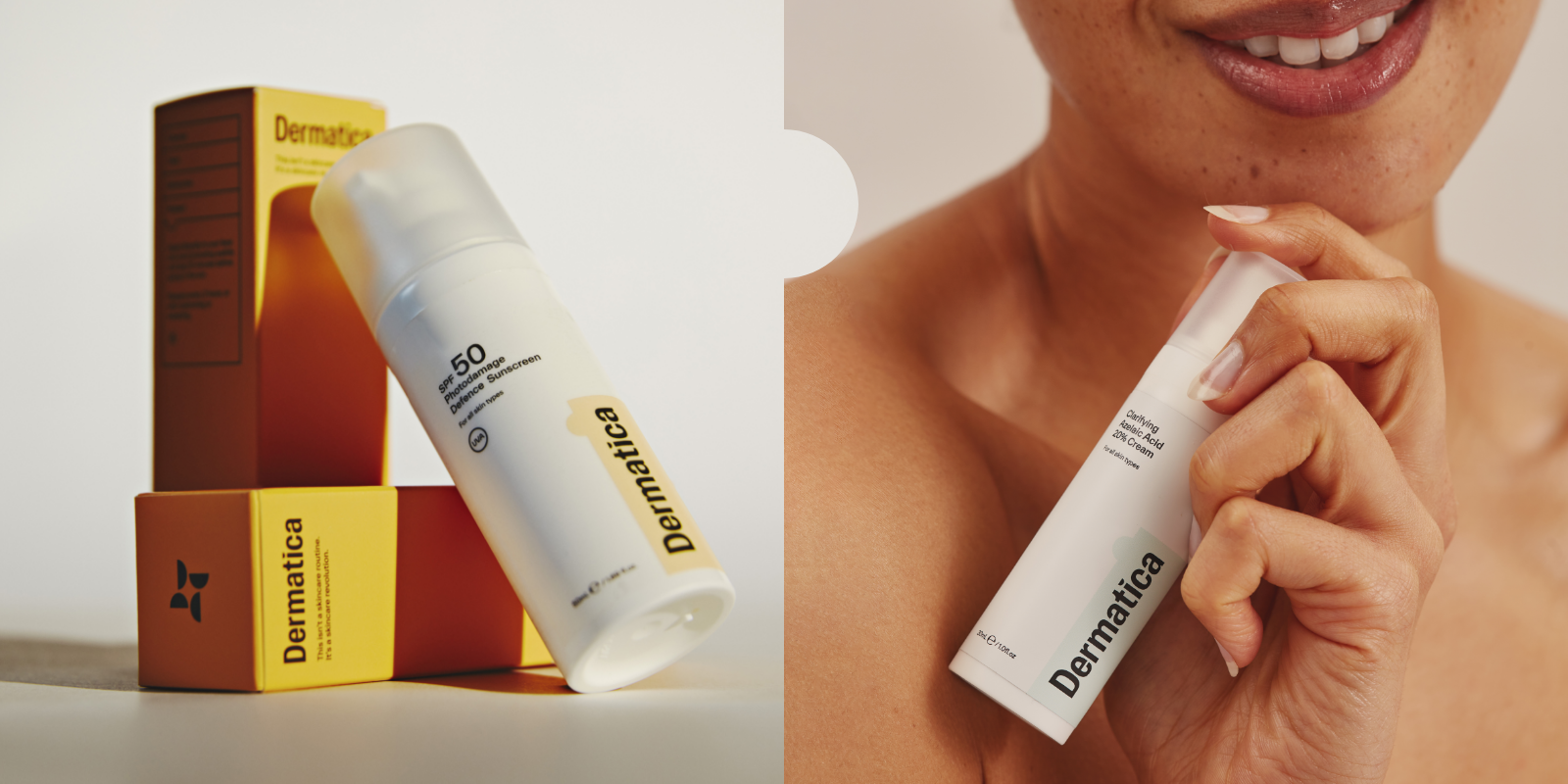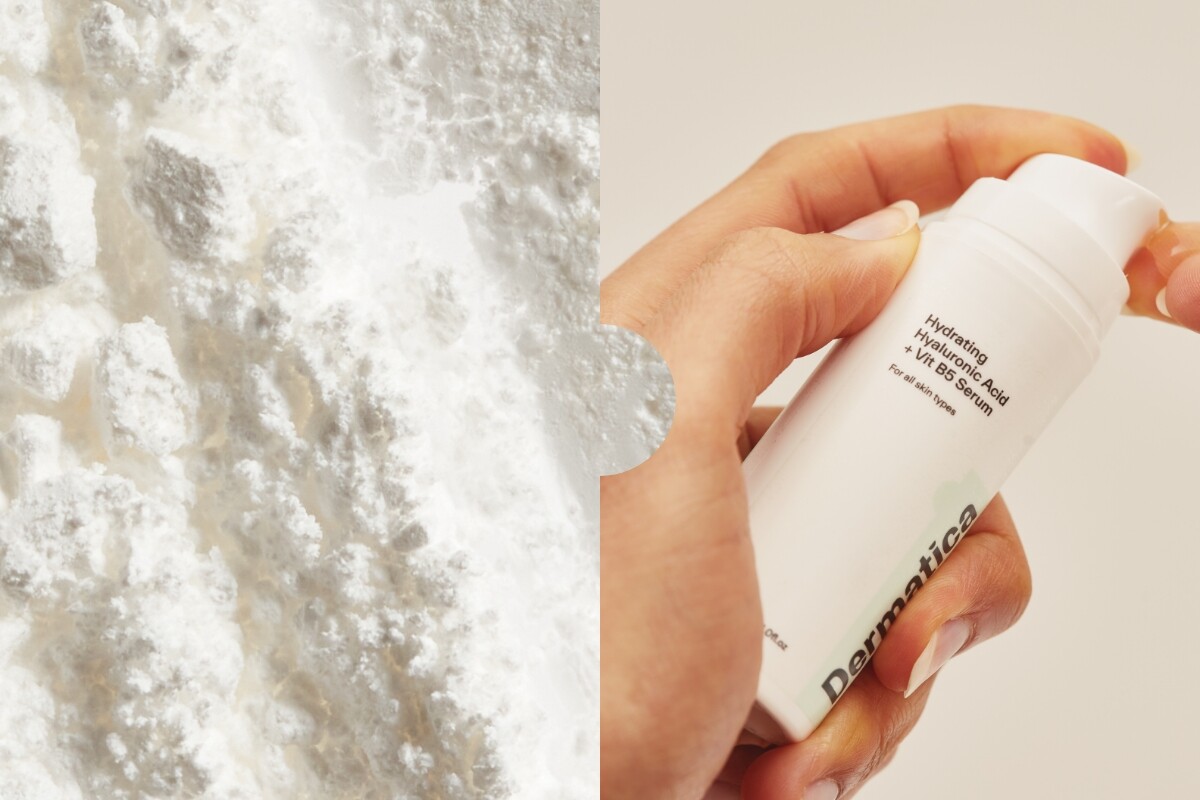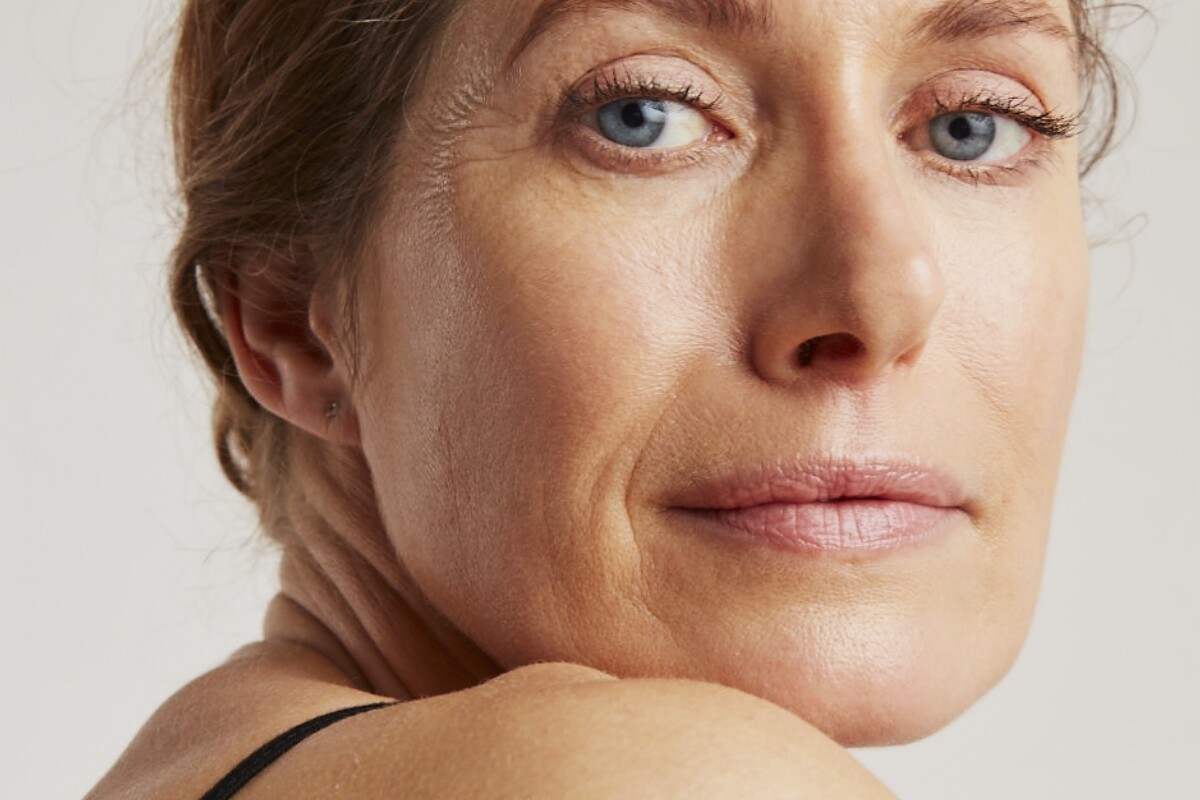We all know the best way to combat sun damage is to not get it in the first place, but that’s much easier said than done. Even some of the most diligent dermatologists and sun protection enthusiasts among us will get some UVA and UVB damage over the course of our lifetimes.
Although we can’t reverse the effects of sun damage on our cell DNA (yet), the good news is there are many science-backed treatment options today that help treat sun damage and photoageing of the skin. Here are the topical (applied to skin) treatments our expert Dermatica team recommend the most.
Broad-spectrum Sunscreen
Almost 90% of visible signs of ageing come from sun damage we accrue from UV radiation over time. (1) The DNA damage this causes can lead to
1. Breakdown and weakening of collagen and elastin in our skin, causing early wrinkles, and thinning or sagging skin.
2. Hyperpigmentation, which can refer to dark spots, age spots, liver spots, brown spots, sunspots and/or melasma.
3. Hypopigmentation, also known as white spots.
4. Skin cancers such as melanoma or basal cell carcinoma.
To avoid sun damage, sunscreen is your most effective offence and defence against the damaging effects of UV rays. Choose one like SPF50 Photodamage Defence Sunscreen with a high SPF (at least 30+ but preferably higher) that clearly states it is broad-spectrum, or has at least a 4-star UVA rating (or equivalent). Make sure you feel comfortable wearing it every day, in any weather. (2)
Sunscreen can help your skin retain its health and appearance well into your later years. It also gives it an opportunity to repair some of the damage on its own. Sunscreen is also a must if you’re using any treatments and creams for sun-damaged skin, as most of them have exfoliating ingredients.
Applying sunscreen from an early age is great, but it’s also never too late to start practising proper sun protection every day.
Antioxidants
The sun’s rays cause oxidative stress on the skin, prompting it to produce free radicals that speed up the premature ageing process. Antioxidant treatments help reduce the amount of free radicals that your skin produces, preventing damage and helping your skin age slower. (3)
Vitamin C
Vitamin C is an antioxidant with a multitude of beneficial properties for sun-damaged skin. The active form, L-Ascorbic acid, not only boosts the SPF protection of your sunscreen – it also encourages your skin to produce more collagen, and has a brightening effect to fade uneven skin tone and the look of dark spots. (4)
Vitamin C is not a prescription ingredient, so you can try it without seeing a dermatology expert first.
Shopping Tips For Vitamin C Skincare
When looking for L-Ascorbic acid products, be mindful that it’s a notoriously unstable ingredient that degrades quickly when exposed to light and air. Try to find one packaged in an airtight, opaque bottle like our Vitamin C 15%: Fresh Batch Ascorbic Acid. Preparations like ours contain ferulic acid and Vitamin E, which help stabilise L-Ascorbic acid, double the photoprotection of your sunscreen and impart even more antioxidant properties to your skin. (5)
Retinoids
Retinoids such as retinol, or prescription types like tretinoin and adapalene, are all derivatives of Vitamin A. These potent ingredients have decades of research for treating visible sun damage.
They have three main positive effects.
1. Retinoids increase how quickly your skin cells renew. This process is called skin cell turnover, or exfoliation, which helps brighten dullness.
2. Prescription-strength tretinoin and adapalene penetrate into multiple layers of skin to boost collagen and elastin production, helping to restore some of the plumpness, moisture and firmness lost from sun damage.
3. Finally, they also help fade uneven skin tone and age spots from sun exposure, also known as sunspots or solar lentigines. (6)
If you’re not sure about a prescription yet, retinol is gentler and available over the counter – but it will be less effective.
Discover if retinol can help treat sun damage.
Azelaic Acid
Azelaic acid is a powerful antioxidant that works similarly to retinoids. It promotes skin cell turnover, which helps fade uneven pigmentation by encouraging the removal of dead, dulling skin cells – revealing fresh, healthy skin cells beneath. (7)
Both acne and rosacea can be triggered or become worse from unprotected sun exposure. What’s more, the skin inflammation caused by these conditions can sometimes lead to a form of dark spots called post-inflammatory hyperpigmentation.
If you’re looking for a product to try, the gentle exfoliating effect of our Clarifying Azelaic Acid Cream is suitable for sensitive skin. It helps smooth skin texture and reduce inflammation from acne breakouts and rosacea. Never used azelaic acid before? Start with the 12% version and increase the strength each time your skin is used to the product.
Azelaic acid is available without a prescription.
Tranexamic Acid
The great thing about tranexamic acid for sun damage is it can improve skin brightness, and it’s safe and effective for almost all skin types including sensitive skin. Regular application will help lighten the look of dullness and enhance skin brightness and clarity.
What’s more, it can also help treat melasma and dark spots by inhibiting the production of melanin pigment and lightening uneven patches triggered by UV exposure, hormonal changes and heat. (7)
Tranexamic acid also helps reduce redness (in lighter skin tones) and skin irritation, and may lower the risk of post-inflammatory hyperpigmentation for people with acne-prone skin. (8)
You can find tranexamic acid in skincare products without the need for a prescription.
Glycolic Acid
A brightening exfoliator, glycolic acid is a type of alpha-hydroxy acid (AHA) that speeds up cell turnover to remove any dead or dulling skin cells faster than without. It also evens out dark patches, smooths the appearance of fine lines and wrinkles, and boosts collagen production in the skin. (9)
Glycolic acid is also the main ingredient in a lot of chemical peels, which is a type of intensive exfoliating treatment that must be done by a dermatologist in their clinic. (10)
Except for chemical peels, glycolic acid is available over the counter without a prescription.
Find more science-backed tips to help roll back the clock on skin ageing here.
Expert tip: Add each of these treatments one by one – preferably under the guidance of a dermatology expert – so you don’t overload your skin with too many active ingredients. Make sure your skin tolerates a new treatment well before adding a new one to your routine.
The longer and more consistently you use them in your skincare routine, the better your results will be – and the more they will improve your skin’s overall health. Always remember, it’s much easier to prevent damage first by staying in the shade and wearing UV protective clothing, hats, sunglasses and sunscreen.
Discover which formulas are suitable for your skin by visiting our website.
References
1. Guercio-Hauer C;Macfarlane DF;Deleo VA. Photodamage, photoaging and photoprotection of the skin. American family physician [Internet]. 2016 [cited 2024 Sep 23];50(2). Available from: https://pubmed.ncbi.nlm.nih.gov/8042567/
2. Schuch AP, Moreno NC, Schuch NJ, Menck CFM, Garcia CCM. Sunlight damage to cellular DNA: Focus on oxidatively generated lesions. Free Radical Biology and Medicine [Internet]. 2017 Jun 1;107:110–24. Available from: https://www.sciencedirect.com/science/article/pii/S0891584917300382
3. Shanbhag S, Nayak A, Narayan R, Nayak U. Anti-aging and Sunscreens: Paradigm Shift in Cosmetics. Adv Pharm Bull [Internet]. 2019;2019(3):348–59. Available from: https://apb.tbzmed.ac.ir/Files/Inpress/apb-24144.pdf
4. Darr D, Dunston S, Faust H, Pinnell S. Effectiveness of antioxidants (vitamin C and E) with and without sunscreens as topical photoprotectants. Acta Dermato-Venereologica [Internet]. 1996;76(4):264–8. Available from: https://pubmed.ncbi.nlm.nih.gov/8869680/
5. Lin FH, Lin JY, Gupta RD, Tournas JA, Burch JA, Angelica Selim M, et al. Ferulic Acid Stabilizes a Solution of Vitamins C and E and Doubles its Photoprotection of Skin. Journal of Investigative Dermatology. 2005 Oct;125(4):826–32.
6. Mukherjee S, Date A, Patravale V, Korting HC, Roeder A, Weindl G. Retinoids in the treatment of skin aging: an overview of clinical efficacy and safety. Clinical interventions in aging [Internet]. 2006;1(4):327–48. Available from: https://www.ncbi.nlm.nih.gov/pmc/articles/PMC2699641/
7. Sauer N, Małgorzata Oślizło, Brzostek M, Wolska J, Katarzyna Lubaszka, Katarzyna Karłowicz-Bodalska. The multiple uses of azelaic acid in dermatology: mechanism of action, preparations, and potential therapeutic applications. Postępy Dermatologii i Alergologii [Internet]. 2023 Jan 1;40(6):716–24. Available from: https://www.ncbi.nlm.nih.gov/pmc/articles/PMC10809820/
8. Basit H, Godse KV, Al Aboud AM. Melasma [Internet]. PubMed. Treasure Island (FL): StatPearls Publishing; 2023. Available from: https://www.ncbi.nlm.nih.gov/books/NBK459271/
9. Batra J, Brar B, Kumar S, Arora H. Tranexamic acid in melasma: Comparative evaluation of therapeutic efficacy of oral tranexamic acid versus its transepidermal administration. Journal of Cutaneous and Aesthetic Surgery. 2022;15(4):394.
10. Narda M, Trullas C, Brown A, Piquero‐Casals J, Granger C, Fabbrocini G. Glycolic acid adjusted to pH 4 stimulates collagen production and epidermal renewal without affecting levels of proinflammatory TNF‐alpha in human skin explants. Journal of Cosmetic Dermatology. 2020 Jul 24;20(2):513–21.
11. Tang SC, Yang JH. Dual Effects of Alpha-Hydroxy Acids on the Skin. Molecules : A Journal of Synthetic Chemistry and Natural Product Chemistry [Internet]. 2018 Apr 10;23(4). Available from: https://www.ncbi.nlm.nih.gov/pmc/articles/PMC6017965/





